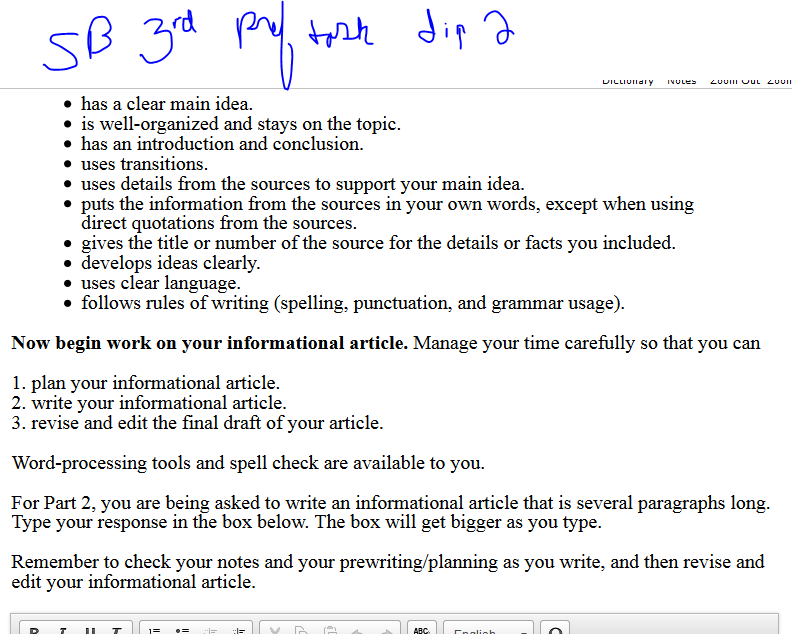Dear School Committee Members, Mr Webster, and Ms Martin,
I
am not sure how many of you have taken a Smarter Balanced practice
exam. I decided to take one. I chose 3rd grade because that is closest
to my daughter's age and I am most concerned with young learners
because the standards were backwards mapped. I chose an ELA exam
because of my history of teaching high school ELA and my Master's in
Literacy Education.
Most of the practice test I found
acceptable. There were many traditional multiple choice questions.
But, some parts concerned me. There were a couple places where I felt
directions were unclear and a couple others where I was unsure if the
content was on target for the grade level. However, there was one
question that shocked me.
First students read this.
The last line is missing because I couldn't fit it on the screen all at
once, but it does not change the meaning of the piece. (Please excuse
my wobbly handwriting from writing with the mouse).
The question concerning this text that concerned me was this:
I taught freshmen English to honors students for five years. Those
students would struggle with this question. *I* struggled with this
question. Are eight year olds ready to be making inferences about an
author's choices in organization? Children learn to read typically
between 5 and 7. Are students who have been independent readers for
such a short span ready for this material? Especially those on the
later end of the window? Also, are they ready to express such a complex
idea in writing?
After the practice test, I decided to
look at the performance task. This part of the exam is designed to go
beyond traditional multiple choice questions and asks students to really
show their mastery. This part of the exam looks like work done in
classrooms. Except: There are zero supports and its all presented at
once to be completed in a short period of time.
When you start the performance task, it looks like this:
Overwhelming, especailly to a child who many have only been reading for a
year. There are three sets of directions visible at once. You can't
see the reading passages needed for the right. A table to fill in, a
text box to type in, all that text read. I'm sure you all can think of
students who will shut down immediately upon seeing this screen.
After
reading all the directions on the left, then the two reading passages
underneath those, and then answering the three questions on the right,
the child moves on to the next screen. The directions on that page are
below.

Here's the second half because you can't even see them all on one screen.
The
text box to type the essay is below the directions. First, how many 8
year olds type well? Is it even appropriate to expect that level of find
motor skills? I really don't know. Either way, the student needs to
scroll up and down to type and see the directions, and also scroll the
direction on the left hand side to read the passages they are supposed
to cite directly. All that for an eight year old.
Also,
these directions look like a direction sheet I would give my 14 year old
students. And those students would struggle with the density of it.
Some would shut down and ignore the directions. Some would try to
follow everything, but inevitably loose track. As someone very
experienced with this type of work, I feel a level of stress and
disengagement thinking about having to sit and make sure I do ALL of
that RIGHT NOW.
Some might think, well, its
supposed to be hard and rigorous. This is not what higher academic
standards look like. Good assessments do not pressure students to
preform in this manner. We make an assessment more rigorous by
increasing the level of complexity for the thinking a child must do to
show mastery. We do not increase the hoops a child needs to jump
through to demonstrate mastery. The task is not my complainant, but
rather how the test design prevents a student from demonstrating mastery
by being overly complex. Consider, if you just sat with a student with
the two texts on paper and then asked the student to talk you through
the answer, does the child stand a better change of demonstrating
mastery? Do those changes to the assessment change what a child knows
or can do? For more on this topic, I highly recommend Rick Wormeli's
Fair Isn't Always Equal or his videos on YouTube.
So,
this is the test which is supposed to give teachers data about a
student's real mastery and determine if the child is college and career
ready. This is the test that is supposed to be used to evaluate a
teacher. This is the test that is supposed to be used to rank Maine
schools. Of course, all of those are flawed lines of reasoning in the
first place, but if we have to use a test, we are going to use this one
that sets these kids up to be overwhelmed and stressed right from the
start?
This is how the Smarter Balanced ELA exam is supposed to work. Technology glitches are the least of our concerns.





No comments:
Post a Comment